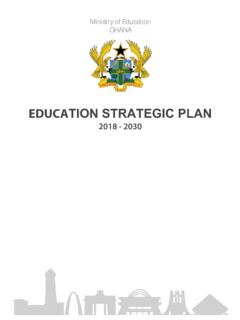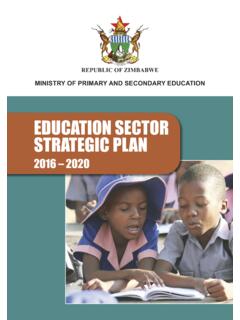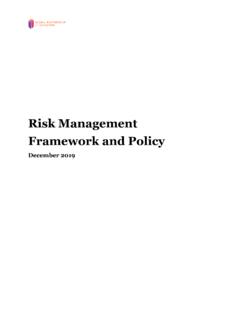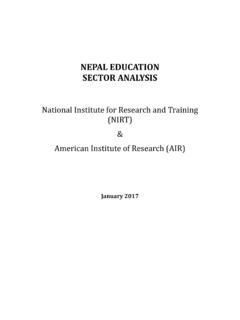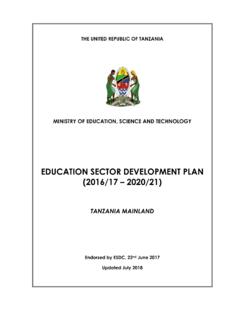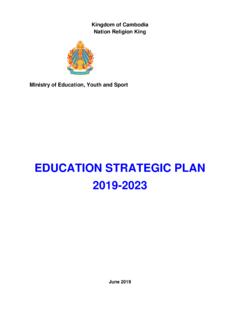Transcription of REPUBLIC OF SOMALILAND MINISTRY OF EDUCATION …
1 I REPUBLIC OF SOMALILAND MINISTRY OF EDUCATION AND HIGHER STUDIES EDUCATION Sector Strategic Plan (ESSP 2017-2021) October 2017 Supported by: ii Contents List of Figures .. vi List of Tables .. vii Foreword .. viii Acknowledgements .. x List of Abbreviations .. xii Executive Summary .. xvi 1. Context of the EDUCATION Sector Strategy Development .. 1 Purpose of the SOMALILAND EDUCATION Strategic Plan 2017-21 .. 1 Methodology of the ESSP .. 1 Methodology .. 2 EDUCATION Sector Analysis .. 2 ESSP Development Process .. 3 Organisation of the document .. 3 Profile of the EDUCATION Sector.
2 4 Vision, Mission, and Goals of the EDUCATION Sector .. 7 2. Policy Context .. 9 Economic and Social Context .. 9 Demographic and social welfare indicators .. 11 Overview of the Achievements and Key Challenges of the ESSP 2012-16 .. 13 Risks and Hazards to EDUCATION .. 15 Projected Trends on Key Indicators for Basic EDUCATION .. 17 3. Key Policy Objectives of the ESSP 2017-2021 .. 20 Policy Objective (1): To increase and expand access to EDUCATION .. 20 Policy Objective (2): To improve the quality of learning outcomes.. 24 Policy Objective (3): To promote equity and inclusion for all students.
3 26 Policy Objective (4): To build institutional and human capacity at all levels of the EDUCATION MINISTRY to facilitate implementation of EDUCATION reforms .. 29 Policy Objective (5): To strengthen the system and review policies in all subsectors .. 31 iii Policy Objective (6): To increase funding for general EDUCATION to support implementation of the SOMALILAND EDUCATION Sector Strategic Plan 2017-2021 .. 33 Policy Objective (7): To monitor and evaluate the implementation of the ESSP .. 35 4. Early Childhood EDUCATION (ECE) .. 37 Situation Analysis .. 37 ECE Policy Context .. 38 Policy Objectives, Strategies, Targets and Activities.
4 39 Priority Objective : Expand and Increase Access and Equity in ECE .. 39 Priority Objective : Improve the Quality and Relevance of ECE.. 40 Priority Objective : Improve Internal and External Efficiencies within ECE Subsector .. 40 Activity Matrix for ECE Subsector .. 42 5. Primary EDUCATION .. 43 Situation Analysis .. 43 Policy Context .. 51 Priority Objectives, Strategies Targets and Activities .. 52 Priority Objective : Expand and Increase Access to and Equity in Primary EDUCATION .. 52 Priority Objective : Improve the Quality and Relevance of Primary EDUCATION .. 53 Priority Objective : Improve Internal and External Efficiencies within the Primary School Subsector.
5 54 Activity Matrix for primary EDUCATION subsector .. 55 6. Secondary EDUCATION .. 58 Situation Analysis .. 58 Policy Context .. 63 Priority Objectives, Strategies, Targets and Activities .. 64 Priority Objective : Increase access and equity of secondary EDUCATION .. 64 Priority Objective : Improve the quality and relevance of Secondary EDUCATION .. 64 iv Priority Objective : Improve Internal and External Efficiency of the Secondary Subsector .. 65 Activity Matrix for Secondary subsector .. 67 7. Non-Formal EDUCATION (NFE) .. 70 Situation Analysis .. 70 Policy Context.
6 71 Priority Objectives, Strategies, Targets and Activities .. 71 Priority Objective : Increase access and equity in NFE .. 71 Priority Objective : Improve the Quality and Relevance NFE .. 72 Priority Objective : Improve Internal and External Efficiency of the NFE .. 73 Activity Matrix for NFE Subsector .. 74 8. Technical and Vocational EDUCATION and Training .. 76 Situation Analysis .. 76 Policy Context .. 78 Priority Objectives, Strategies, Targets and Activities .. 78 Priority objective : To Improve and Promote of TVET access and equity .. 78 Priority objective : To enhance quality and relevance of TVET trades and strengthen capacity of TVET/TVQA Staff.
7 79 Priority Objective : To increase internal and external efficiencies and harmonize assessment and employment procedures for TVET trainees.. 80 Activity Matrix for TVET Subsector .. 81 9. Higher EDUCATION .. 84 Situation Analysis .. 84 Policy Context .. 87 Priority Objectives, Strategies, Targets and Activities .. 87 Priority Objective : Expand and Increase Access and Equity in Higher EDUCATION .. 88 Priority Objective : Improve the Quality and Relevance of Higher EDUCATION .. 88 Priority Objective : Improve Internal and External Efficiencies within the Higher EDUCATION .. 89 v Activity Matrix for Higher EDUCATION .
8 91 10. Cross-cutting Themes, Governance and Institutional Capacity Considerations .. 93 Situation Analysis .. 93 Policy Context for Cross-cutting issues .. 97 Priority Objectives, Strategies, and Activities for Cross-cutting Activities .. 97 Priority Objective : To Improve and strengthen governance and Institutional Capacity development for MOEHS system .. 98 : Priority Objective : To build the institutional capacity of the Curriculum institute .. 98 : Priority Objective : To establish full functioning of SOMALILAND National College of EDUCATION .. 99 Priority Objective : Generate reliable evidence-base for EDUCATION sector planning and 99 Priority Objective : To decentralize primary EDUCATION functions to the local governments.
9 100 Priority Objective : Implement reliable and effective annual national 100 Priority Objective : Ensure that children access EDUCATION in safe and protected learning environments in situations of emergency .. 101 Activity Matrix for Cross cutting and systems strengthening .. 102 11. Monitoring Plan .. 106 Key Result Indicators .. 108 12. Critical Assumptions and Risks .. 111 Risks and mitigation measures .. 111 13. Costing and Financing of the ESSP 2017- 2021 .. 120 Situation Analysis .. 120 Projections of Government Spending on Capital Costs (2017-2021) .. 125 Summary costing and financing of the ESSP.
10 129 Annex 1 Detailed ESSP Monitoring Implementation Framework .. 132 References .. 170 vi List of Figures Figure 1. Disaggregation of employment by Gender and Rural-urban Classifications .. 11 Figure 2. Projections on School-age Population (6-13 14-17 yrs) .. 17 Figure 3. Total School-Age Population and Out-of-School Children .. 18 Figure 4. Qualified Teacher Trends and Pupil-Teacher Ratio .. 45 Figure 5. Gender Equity indicators Promoting enabling Environments for girls .. 47 Figure 6. Total Primary Teachers (Including ABE and IQS), 48 Figure 7. Secondary Enrolment by Form for the year 2014/15.
